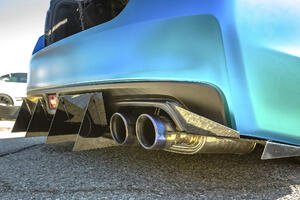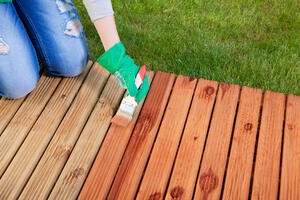
by Flagship Staff | Sep 15, 2020 | Blog
Planting a tree in your yard can be beneficial to your family. Not only do trees provide beauty, they offer many additional benefits such as:
- Cleaning the air we breath
- Increasing your home’s value
- Providing shelter for birds and other animals
- Preventing soil erosion
- Reducing rainwater runoff
- Helping reduce stress and anxiety
While severe weather can bring down trees, causing property damage, it’s important to realize there are other reasons a tree or branch may fall. Reasons include insect infestations, old age, poor soil conditions, malnutrition, and flooding.
Signs your tree could fall
There’s no way to tell exactly when or if your tree is going to fall. However, there are some things to watch for.
- Leaning tower of Pisa. There are several trees in my neighborhood that are leaning. However, at this point they’re smaller and of no concern. If you have large trees in your yard that have a significant lean, it may be time to contact a professional to discuss their removal. Tree lean can be caused by wind or root damage.
- Inadequate nutrients. If you notice dead or falling branches, it may be the result of a lack of nutrients. Thoroughly inspect your tree(s). If the branches are low and small, you may be able to remove them yourself. If not, contact a professional for assistance.
- Falling leaves. Leaves can fall from your tree(s) for a variety of reasons such as:
- Disease
- Too much or too little water
- Canopy crowding
If fallen leaves are green, your tree is probably fine. If the leaves are discolored or look sick, there may be an issue. In addition, if the leaves are falling from the outside in there may be a root issue. Lastly, some diseases or pests can attack the tree and destroy it over time which can weaken the tree and pose a threat to your family.
- Proximity to water. Living on a waterfront is a dream of many. However, watch out for trees that are close to the water. Excessive water can cause the roots to become waterlogged. Over time, this can cause them to decay and decrease structural stability.
- Cracks in the trunk. It’s normal for trees to have cracks or holes. If they’re large, it’s important to have them examined to see how extensive they are. They could be a sign of a diseased tree and again, the structural integrity can be compromised.
Tips for maintaining healthy trees
- Proper mulch. Mulch can help retain moisture which is good for the tree’s root system. It also keeps the soil cool and can prevent weeds from growing.
- Adequate water. Newly planted trees need to be watered regularly. Mature trees need to be watered during times of drought. Set your hose at the base of the tree and let your water flow at a slow trickle for 20-30 minutes.
- Proper pruning can improve the strength and structure of your trees. However, it’s important to make the proper cuts at the correct time of the year. To learn more, click here.
- Watch for unwanted insects. Insects such as Japanese beetles, Adelgids, and caterpillars can invade your trees without you knowing. These pests can cause serious damage, including weakening the tree. If your tree is small, you may be able to spray an insecticide on it. If it’s too big, you may be able to use a granular powder that not only provides nutrients but also prevents insects. If in doubt, contact your local tree professional for assistance.
If your trees are not properly maintained, there may not be coverage on your homeowners policy.
Claims Scenarios
A common claim scenario that insureds deal with after a storm is fallen trees. High winds and saturated ground can create the perfect storm. Most standard homeowners policies provide some coverage.
Claim Scenario 1
A tornado rolls through the outskirts of your city. While your house wasn’t directly hit by it, tree branches flew through the air, breaking windows and damaging your siding. Even though your trees survived and didn’t cause this damage, a standard homeowners policy would provide property damage coverage.
Claim Scenario 2
As you’re enjoying a nice summer day on your patio, you notice dark clouds approaching. As the trees begin to sway, you decide to take shelter indoors. After the storm passes, you survey the damage and find a downed tree and damaged shrubs. As a result, you contact your independent insurance agent to see if you have coverage. A standard homeowners policy could provide coverage for up to $500 for the removal of any one tree and up to $1,000 for any one loss. Unless stated differently in the policy, your homeowners deductible would apply to this type of loss.
Claim Scenario 3
As you’re preparing dinner, a severe summer storm passes through. You hear a loud noise and notice the neighbor’s tree has fallen on your property. After further inspection, you realize the tree has crashed down on your roof causing significant damage. In this scenario, not only are you responsible for the cleanup, you’d have to contact your independent agent to see if coverage is available for the damage your home sustained.
If you can prove the neighbor’s tree was dead, diseased, or not properly maintained, your neighbor could be responsible for your property damage due to negligence.
Claim Scenario 4
After a trip to the grocery store, you arrive home and leave your car parked in the driveway. Suddenly, a severe summer storm blows into your neighborhood. High winds cause large trees surrounding your home to fall on your roof and your car, causing significant damage. In this scenario, a standard homeowners policy covers damage caused by a fallen tree if the cause of loss (peril) is wind. To have coverage for your car, you must have an auto policy with comprehensive insurance coverage.

by Flagship Staff | Sep 8, 2020 | Blog
Whether you plan to do a custom paint job or add a major modification like a supercharger, customizing your car can have insurance ramifications. If you’re enhancing your car, you may be wondering, “Should I call my insurance agent about special auto insurance coverage if I customize my car?” The answer is yes.
Modifications a standard policy will/won’t cover
Most auto insurance companies regard customization/modifications as anything that isn’t offered by the original manufacturer of the car or installed by the dealer as a part of the original sale. Examples of popular modifications drivers make to their vehicles, and which usually require supplemental or separate insurance, include:
- Custom paint job, murals, graphics, or decals
- Electronic equipment like a custom stereo, PC, TV, or video system
- Custom tires, wheels, or spinners
- Custom spoilers, louvers, scoops, or grilles
- Speed enhancements like turbochargers and blowers
- Anti-roll/anti-sway bars
- Added chrome
- Accent/auxiliary lights
- Suspension enhancers/hydraulics
- Fuel pump deletion kits
No matter how you modified your car, it’s important to call your insurance agent. Be specific about the types of modifications you made. While you may be tempted not to tell your insurance agent about your customizations for fear that your premiums could increase, it could cost more if you don’t get the proper coverage. That’s because if there’s an accident, you may not be reimbursed for the enhancements you made to your car. Here’s why:
- A standard auto policy is typically an actual cash value policy: Actual cash value is the fair or reasonable cash price for which property could be sold in the market, in the ordinary course of business, and not at forced sale. It’s the price it will bring in a fair market after reasonable efforts to find a purchaser who will pay the highest price. When you modify a vehicle, it narrows the market value. The average auto consumer may not value the $6,000 suspension lift kit and rear spoilers and might even associate the enhancement(s) with possible misuse of the auto which limits potential buyers and lowers its market value.
- Depreciation: As modifications get older, very little value is added. Tires depreciate during each use due to wear and tear, and electronic equipment becomes outdated quickly due to short product cycles and new technology enhancements.
- Possible denial of coverage: If you install a kit that turns off the manufacturer’s prevention measures or if you use your vehicle in racing, you could be denied coverage in the event of a loss. Most insurance companies won’t provide coverage if you turn off safety mechanisms in your car or crash while racing — legally or otherwise. This includes damages sustained while test driving your car on a racetrack.
What are my options for retaining the value of my customizations?
Although a standard auto policy will most likely not reimburse the value of all customizations if you need to file a loss claim, call your agent to discuss two possible options that can help retain your customization value:
- Supplemental Coverage: Many insurers offer endorsements that provide supplemental coverage for modifications and aftermarket components on a case-by-case basis.
- Classic/Collectible/Stated V Car Insurance: “Stated cash value” or “agreed value” policies are just as they sound: You and your insurance company both agree on the value of your vehicle and it doesn’t depreciate.
Before you take that car for a spin, just remember: If you modify/customize your car, it’s best to save receipts, take photos, and call your insurance agent to ensure your auto is adequately insured.
Do you have any tips you’d like to share? I’d love to hear them; please share them in the box below.
This blog was written by Wendy Wagner, Personal Lines senior underwriter.
Topics: Auto Insurance

by Flagship Staff | Sep 1, 2020 | Blog
If you live in an older home, chances are some things may not be working as well as they used to. In some cases, problems in your home can lead to unsafe conditions. As a homeowner, it’s important to know the signs that something in your home is unsafe, as it can help protect you and your family.
In this article, we’ll discuss four common signs your home may be unsafe. While this information isn’t meant to alarm you, it’s important for you, as a homeowner, to recognize and understand the signs of danger.
You have pests
Common household pests can pose a variety of safety issues for you and your home. Some pests, such as termites, can cause structural damage to your home. The worse a termite infestation is, the more unsafe the stability of your home becomes. Other pests, such as rats and cockroaches, can carry and transmit harmful diseases.
If you notice these pests in your home, you’ll need to take care of them immediately. Termites may be harder to find and deal with, which is why it’s important to do termite inspections annually. A single rat or cockroach in your home usually isn’t a serious problem, but the longer you leave these pests unattended, the more potential for a real infestation arises.
You get sick a lot
If you notice yourself getting sick frequently, the culprit may be something in your home. Symptoms such as shortness of breath, coughing, headaches, itchy eyes, runny nose, rashes, and asthma attacks can all come from household issues. Mold growth is common in homes and can contribute to sickness and respiratory problems. Asbestos exposure can also cause these issues, especially in older homes. If these symptoms are common for you in your home, you may want to get it inspected for mold or asbestos.
Your deck is uneven
An uneven deck can be a sign of an unsafe deck. If your deck is unstable, you run the risk of the deck breaking, which can lead to serious injury or death under certain circumstances. Other signs of an unsafe deck include rotted or cracked wood, uneven boards, and unsteady railings. If your deck shows signs of any of these, get it inspected and fixed before the deck fails and causes severe damage.
You notice unusual smells
Persistent unusual smells in your home can be a sign of a gas leak, pest infestation, and more. Gas leaks may smell like rotten eggs. Gas leaks can easily start fires and cause physical symptoms, so if you notice this smell, you need to get it fixed. Other smells, such as rotting or urine-like odors, can be signs of dead animals or infestations. Other common unusual smells are fishy or burning odors, which can be caused by faulty electrical wiring or burns.
There are cracks in your foundation
If the foundation of your home is unstable, you may notice cracks in the interior and exterior of your home. These cracks may be located in your floorboards, sidewalk, bricks, or siding of your home. As your foundation becomes more unstable with time, the worse the problem becomes and the more unsafe your home becomes. If you notice cracks, address the problem immediately.
While most of these issues can cause problems, don’t let them put you into a constant state of fear. An unusual smell every once in a while usually isn’t reason to panic. But being aware of these signs is still just as important. As a homeowner, you should know what your house needs. The more you know, the better prepared you’ll be when something goes wrong.
Do you have any tips you’d like to share? I’d love to hear them; please share them in the box below.
Author bio: Brie Taylor is a freelance writer who is passionate about home improvement and the outdoors. If she isn’t writing, you can find her biking on local trails or working on her latest DIY project.
Topics: Home Safety

by Flagship Staff | Aug 25, 2020 | Blog
Keeping your deck looking nice is a tough job. Mother Nature throws a lot of different weather elements at it. As an owner of a cedar deck, I’ve spent plenty of hours trying to keep it looking its best. If summer has been simply too hot or you’ve been putting it off, now may be the time to start thinking about it.
Here are some tips to help you with your project.
Stain vs. paint
No matter what type of deck you have, finishing it with stain or paint will protect it from the weather, and increase its lifespan. So, if you’re wondering what the difference is between the two, here we go!
Stain
- If your deck is brand new, a transparent stain is a good choice. This allows you to enjoy the wood’s natural beauty.
- Stain is usually cheaper per gallon.
- Staining doesn’t require the use of primer and it’s easier to apply.
- Stain does require more regular maintenance.
- Stain works well on newer decks.
Paint
- Paint offers a wider variety of color choices and allows for more creativity.
- Paint lasts longer.
- Paint allows for easier surface cleaning.
- As a deck ages, this becomes a nice option to hide some of the imperfections in the wood.
Sandpaper types
Whether you’re sanding your deck or working on another project, understanding sandpaper grit can help you be more efficient, and provide you with a nice finished product.
- Extra course sandpaper (34 – 36 grit) can be used for difficult jobs where paint and varnish need to be removed.
- Course sandpaper (40 – 50 grit) may also be used for removing finishes, as well as polyurethane.
- Medium sandpaper (60 – 100 grit) can be used for sanding rough wood.
- Fine sandpaper (120 – 220 grit) can be used for work that’s near completion to create the finishing touch.
- Extra fine sandpaper (240, 320, 400 grit) can be used to remove small blemishes or inconsistencies from a finish that has been applied. It won’t remove the finish like a course sandpaper would.
Preparation steps
Before applying your stain or paint it’s important to make sure your deck is properly prepared.
1. Remove debris. Decaying leaves, bird droppings, and berries that have fallen off your trees can make a real mess on your deck. Make sure you give it a good sweep or use a blower.
2. Apply a cleanser. To remove any tough remaining stains thoroughly apply a cleanser. Let it soak for the manufacturer’s recommended time period and then thoroughly scrub it with a stiff bristle brush. When you’re finished, rinse the cleanser from the wood using a garden hose or pressure washer. If you use a pressure washer, be cautious. A high-powered pressure washer can damage the wood. Allow 48 hours for the wood to dry.
3. Apply a stain/paint remover. For the best results, removing the remaining paint or stain is key. However, this process can be very time consuming. To see what options you have, I recommend talking to your local hardware or paint store. Some paints may allow you to go over the old stain/paint without spending a lot of time stripping the wood.
4. Inspect the boards. Before painting or staining it’s important to look for loose nails and screws, as well as imperfections in the wood. If you find loose nails or screws, remove them, and insert new ones. If nail or screw heads are not flush with the boards also consider removing them and inserting new ones. This can help prevent injury.
If you notice large cracks, consider filling them with an epoxy putty. The epoxy can be applied easily with a putty knife. Make sure to let it dry thoroughly before sanding or painting. Don’t forget to fill nail holes or rotted wood with putty as well.
5. Sand ridged, rough, or uneven surfaces. Based on your job, refer to the sandpaper types above to effectively carry out this step. Make sure to remove excess dust when you’re finished.
6. Take a little extra time. Using painters’ tape, take some time to properly cover up surfaces that you don’t want painted or stained. This would include your home’s siding, aluminum spindles, and around doors. If you have plants around your deck, consider using a drop cloth or plastic to protect them. However, don’t leave the coverings on for extended periods of time.
7. Caulk the joints. If you have wood joints that don’t come together like they used to, consider using caulk to fill in the space. On my deck, I notice this happening particularly around the posts.
8. Apply paint or stain. Follow the manufacturer’s directions for application. It’s important to monitor temperature and potential precipitation.
As I mentioned, keeping your deck looking good is a tough job. However, the enjoyment and relaxation it can provide is worth it!
Do you have any tips you’d like to share? I’d love to hear them; please share them in the box below.
Source
https://www.bobvila.com/articles/painting-vs-staining-a-deck/
https://www.bobvila.com/articles/2145-quick-tip-choosing-sandpaper/
Topics: Home Safety, Yard Safety

by Flagship Staff | Aug 18, 2020 | Blog
The first five years of a child’s development provide a good foundation for long-term academic and social benefits so choosing a quality daycare provider for your child is very important. This blog will offer tips for parents when choosing a daycare provider, as well as tips for in-home daycare providers.
Parents:
There are many factors to considering when choosing an in-home daycare service.
You should first determine if the state requires the provider to have a license. Each state sets a limit on the number of children a provider may care for before a license is required. Be sure to find out what your state requires. Ask the provider how many children are cared for in the home and if the provider is properly licensed if necessary.
The provider should also have proper insurance. Sometimes this coverage is provided on a homeowner’s policy. If the daycare provider will be transporting your child in their personal vehicle, it’s also important to make sure they have the proper auto insurance, as well as appropriate and safe car seats.
Here are other things you should review with the provider before making your decision:
- Make sure the provider is trained in first aid and child/infant CPR.
- Make sure the provider keeps important medical information, including children’s allergies, doctors’ phone numbers, etc.
- Provide written consent for your child’s emergency medical care or treatment.
- Only authorized persons will be allowed to pick up your child.
- Make sure the home is equipped with fire extinguishers and smoke detectors.
- Outside play areas should be in good condition with proper safety features.
- If there’s a swimming area, it should be fenced and locked.
- The home should be childproofed, including:
Window blind pull stings are looped up and out of reach.
Cribs are placed out of reach of windows and window treatments.
Stairs are blocked off by stair gates.
Changing tables and high chairs have straps to secure children.
Outlet covers are firmly in place.
Toys are clean and in good condition.
Potentially toxic substances are secured out of reach of children.
Providers:
- As with parents, it’s vital that you know how many children you may care for before a license is required. Check with your state’s authorities.
- The proper insurance for your home and operation, as well as for any vehicles in which you may transport children, is also vital. Be sure to talk to your insurance agent to determine if you have coverage, if you need to add it to your policy, or if you need to purchase an additional policy.
- Make sure your home is properly childproofed.
- Be sure to obtain important information for each child, including medical information and consent, and the names of people who are authorized to pick up each child.
- Check the local YMCA or Red Cross in your area to see if they provide babysitting classes, first aid/CPR and/or other classes that offer certifications related to childcare.
- If you have more than three persons, you will need a separate business policy.
For parents, choosing the right daycare provider is one of the most important decisions they’ll ever make. For providers, caring for children is rewarding and enjoyable. Making sure the children are in a safe environment gives both parent and provider peace of mind.
For additional information, visit our Culture of Safety blogs below.
Choosing the Right Childcare: Understanding State Licensing Reports
Choosing the Right Childcare: Staff Ratios

by Flagship Staff | Aug 11, 2020 | Blog
For my wife, keeping our cars clean has always been a priority. While she likes a shiny car on the outside, she’s more focused on keeping the interior spotless. I often joke with her that nobody can see the interior.
As we navigate through the COVID-19 pandemic, cleaning your car may have jumped up on your priority list. Or if you’re looking for something to do on a beautiful summer day, this project may be for you. No matter what the situation, here are some tips for cleaning your car inside and out.
1. Use the proper soap. When I was a kid, I washed my parent’s car all the time with dish detergent. It smelled good, was cheap, and produced a lot of bubbles. I thought, the more bubbles I had, the cleaner the car. Today, I only wash my cars with soap that has been specifically formulated for this. Check out your local auto parts store to see what products are available.
2. Control the dust. Do you have dust rolling around in your car like a tumbleweed in the desert? If so, it’s time to bring in the reinforcements. To keep dust at a minimum, and to clean your car more effectively, using a brush and vacuum can help tremendously. For me, using paper towel and a spray cleaner is aggravating because it just smears dust around. Lastly, a small brush and vacuum do a great job cleaning nooks and crannies, as well as vents, radio knobs, or heat dials.
3. Sanitize high touch points. You may think this is a challenging task because you don’t have access to disinfectant wipes or other cleaning products. However, there’s no need to worry. High touch point objects can simply be cleaned with soap and water. While dish soap isn’t the best for the exterior of your car, it works great for cleaning the interior. This is because dish soap is made with mild detergents which won’t damage interior materials. A clean rag or microfiber towel will do a fantastic job. Just make sure to ring it out prior to using it. You don’t want excess water pooling or seeping into places it shouldn’t be.
In the past, the only item you may have considered a high touch point was your steering wheel. Today, there are many more touch points to consider to keep your family healthy. Items include:
- Seat belts
- Cup holders
- Radio knobs or dials
- Touch screens
- Door handles
- Gear shifter
- Steering wheel controls
- Car seats
If you don’t enjoy cleaning your car on a regular basis, keep it germ free by using hand sanitizer before you get into your car.
Lastly, never use bleach or other harsh chemicals to clean your car.
4. Embrace the power of magic. My wife loves using the Magic Eraser for different household chores. At first, I was a bit skeptical, but now I’m a fan. If you have stubborn spots of dirt or grime in your car, give it a try. Don’t forget to squeeze out the excess water.
5. Conquer the Crumbs. If you have stubborn crumbs everywhere in your car that you just can’t get rid of, consider using a toothbrush. The bristles of a toothbrush may be just enough to loosen them and get them out of tiny places.
6. Don’t neglect your windshield wipers. Windshield wipers are critical to keeping you safe. Windshield wipers take a beating from the elements. Dirt, debris, and sunlight contribute to the breakdown of the wipers’ rubber blades. If your windshield wipers are leaving streaks, try cleaning them with rubbing alcohol. If that doesn’t work, it may be time to replace them.
7. Replace your cabin filter. If your car smells musty all the time, it may be time to change your cabin filter. The cabin air filter helps keep dust, dirt, pollen, bacteria, and other things from entering your car through the HVAC system. To keep your car smelling fresh, consider changing your filter yearly or every 12,000 miles. If you drive in dusty or polluted conditions, you may have to change it more regularly.
8. Buy a squeegee. If your pet loves riding in your car, it may be waiting by the door when it hears you grab the car keys. If you have fabric upholstery, after a few rides it may be time to for fur removal. Consider dampening the fabric with a light mist of water. Then, use a squeegee to remove the fur. Have a vacuum standing by to suck it up.
9. Wipe away those pesky bugs. If you’re like me, bug guts on the front of your car may drive you buggy. Bug guts are difficult to remove. Luckily, there are products available at your local auto store that can help. If you’re looking for a home remedy, give a bucket of warm water and fabric softener sheet a try.
10. Invest in cupcake liners. If you’re tired of the debris that collects in your cup holders, consider using cupcake liners. While it may not look pretty, once they fill up with debris, simply toss them in the garbage and insert new ones.






